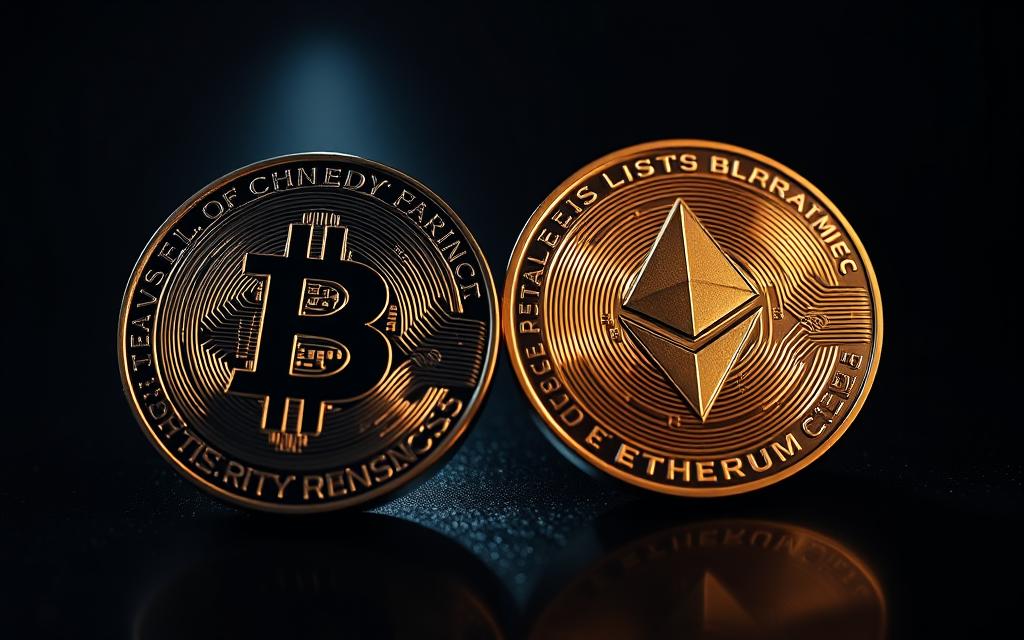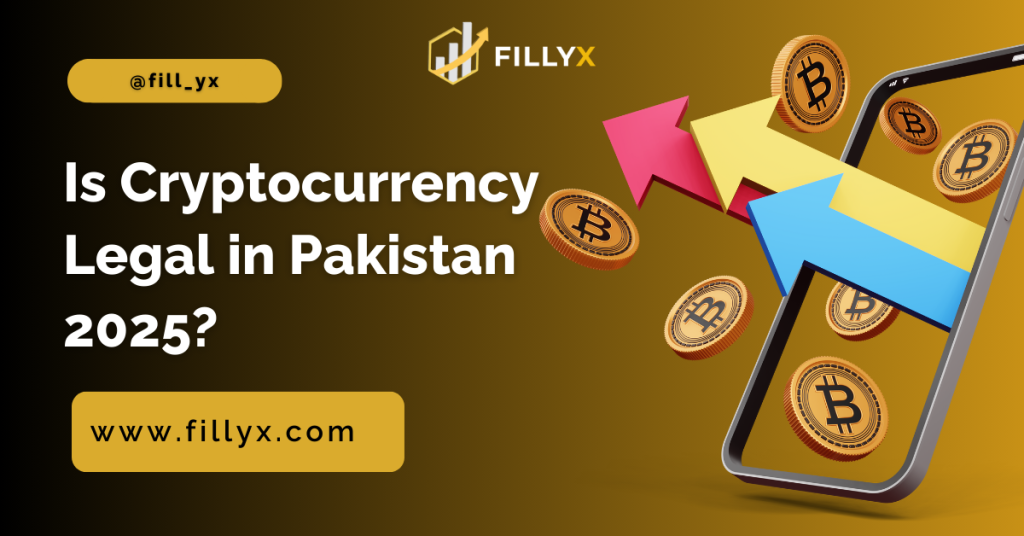Five Reasons Why Fillyx Is the Best Cryptocurrency Exchange in Pakistan

Introduction Cryptocurrency trading has taken Pakistan by storm, with millions of users diving into the digital asset market despite regulatory uncertainties. Fillyx has emerged as a top exchange which offering a seamless and secure trading experience tailored to Pakistani users. Whether you’re a beginner dipping your toes into Bitcoin or an experienced trader exploring altcoins. It stands out as the Best Cryptocurrency Exchange in Pakistan. In this article, we’ll explore five compelling reasons why Fillyx is the go-to platform for crypto enthusiasts in Pakistan. 1. Seamless Support for Local Payment Methods One of the biggest issues for Pakistani crypto traders is finding an exchange that supports local payment methods. This exchange addresses this challenge head-on by offering seamless integration with popular Pakistani payment systems like JazzCash, Easypaisa, and NayaPay. This allows users to deposit and withdraw funds in Pakistani Rupees (PKR) without the hassle of complex currency conversions. Why It Matters: In a country where traditional banking systems are restricted for crypto transactions, Fillyx’s support for local payment methods simplifies the process, saving users time and effort. Whether you’re in Karachi, Lahore, or a remote area, It ensures you can trade effortlessly. 2. Robust Security Measures for Peace of Mind Fillyx prioritizes user safety by implementing advanced security protocols, including two-factor authentication (2FA). It also provide cold storage for the majority of funds, and end-to-end encryption to protect user data. These measures ensure that your assets and personal information remain secure from external threats. Additionally, This platform adheres to strict Know Your Customer (KYC) and Anti-Money Laundering (AML) policies, creating a transparent and trustworthy trading environment. Why It Matters: The collapse of exchanges like FTX in 2022 highlighted the importance of choosing a platform with robust security. Fillyx’s focus on safeguarding user assets makes it a standout choice, offering peace of mind in a volatile market. 3. User-Friendly Interface for Beginners and Experts Navigating the crypto market can be daunting, especially for newcomers. Fillyx shines with its intuitive and user-friendly interface, designed to cater to both beginners and seasoned traders. The platform’s clean layout, clear price charts, and straightforward trading options make it easy to buy, sell, or trade cryptocurrencies like Bitcoin, Ethereum, and USDT. Why It Matters: Fillyx’s accessibility makes it the Best Cryptocurrency Exchange in Pakistan for users of all skill levels. Whether you’re making your first trade or executing complex strategies, the platform’s design ensures a smooth experience. 4. Competitive Fees and Transparent Pricing Trading fees can eat into your profits, especially in a high-frequency trading environment. Fillyx stands out by offering some of the most competitive fees in the market, with spot trading fees as low as 0.1%. The platform also provides discounts for users who hold its native token (if applicable) or generate high trading volumes, further reducing costs. Why It Matters: Low fees and transparency are critical for maximizing returns, especially for frequent traders. Fillyx’s cost-effective approach makes it an attractive option for Pakistani investors looking to optimize their trading strategy. 5. Wide Range of Cryptocurrencies and Trading Options Fillyx offers an impressive selection of over 200 cryptocurrencies, including major coins like Bitcoin (BTC), Ethereum (ETH), Ripple (XRP), and Tether (USDT), as well as promising altcoins. This diversity allows Pakistani traders to build varied portfolios and capitalize on emerging market trends. This exchange also offers access to DeFi protocols and NFT trading, keeping users at the forefront of crypto innovation. Why It Matters: A wide range of assets and trading options empowers users to diversify their investments and explore new opportunities. Fillyx’s comprehensive offerings make it the Best Crypto Exchange in Pakistan for traders seeking flexibility and growth potential. Why Fillyx Stands Out as Best Cryptocurrency Exchange in Pakistan Pakistan’s crypto market is growing rapidly, with an estimated 27 million users expected to trade digital assets by 2025. Despite this surge, the regulatory landscape remains uncertain, with the SBP yet to legalize cryptocurrencies. Fillyx navigates this grey area by offering a platform that complies with international standards while catering to local needs. Its support for PKR transactions, robust security, user-friendly design, competitive fees, and diverse asset offerings make it a top choice for Pakistani traders. How to Get Started with Fillyx: Ready to start trading with Fillyx? Here’s a quick guide to begin your crypto journey: Sign Up: Visit Fillyx and create an account with a valid email and secure password. Fund Your Account: Use local payment methods like JazzCash, Easypaisa, or bank transfers to deposit funds. Explore Cryptocurrencies: Browse Fillyx’s wide range of digital assets and use real-time market data to make informed choices. Start Trading: Execute trades effortlessly, whether you’re investing long-term or trading daily. Stay Secure: Enable two-factor authentication (2FA) and use a secure wallet to protect your assets. By following these steps, you can leverage Fillyx’s features to build a successful crypto portfolio with ease. Conclusion about Best Crypto Exchange in Pakistan If you’re searching for the Best Crypto Exchange in Pakistan, look no further than Fillyx. With its user-friendly interface, top-notch security, competitive fees, diverse cryptocurrency offerings, and outstanding customer support, Fillyx is the ultimate platform for traders of all levels. Whether you’re new to crypto or an experienced investor, Fillyx provides the tools and resources you need to succeed in the fast-paced world of digital assets. Ready to start your crypto journey with the Best Cryptocurrency Exchange in Pakistan? Join Fillyx today and experience secure, user-friendly, and cost-effective trading tailored to your needs. Sign up now at Fillyx.com and take advantage of low fees, local payment options, and a wide range of cryptocurrencies. Don’t miss out—start trading smarter with Fillyx! FAQs 1. Is Fillyx safe to use for crypto trading in Pakistan? Yes, Fillyx is a secure platform that implements advanced security measures like two-factor authentication (2FA), cold storage, and encryption. It also complies with KYC and AML regulations to ensure a transparent trading environment. 2. Can I use Pakistani Rupees (PKR) on Fillyx? Absolutely! Fillyx supports PKR deposits and withdrawals through local payment methods like JazzCash, Easypaisa,
Exploring the Bitcoin vs Ethereum Debate: What You Need to Know

The world of cryptocurrencies is a dynamic and ever-evolving landscape, with Bitcoin and Ethereum standing as the two most prominent players. As the pioneers of blockchain technology, they have sparked endless debates among investors, developers, and enthusiasts about their respective strengths, weaknesses, and long-term potential. This article delves into the Bitcoin vs. Ethereum debate, exploring their fundamental differences, use cases, technological underpinnings, and what they mean for the future of decentralized systems. The Origins of Bitcoin and Ethereum Bitcoin: The Digital Gold Bitcoin is launched in 2009 by the pseudonymous Satoshi Nakamoto It was the first cryptocurrency to gain widespread recognition. BTC designed as a decentralized peer-to-peer (P2P) payment system. Bitcoin aimed to create a “trustless” network, eliminating the need for intermediaries like banks or governments. Its core innovation lies in its blockchain, a public ledger that records all transactions transparently and immutably. Bitcoin’s primary goal is to serve as a store of value and a medium of exchange, often likened to “digital gold” due to its fixed supply cap of 21 million coins and its resistance to inflation. Bitcoin operates on a Proof-of-Work (PoW) consensus mechanism, where miners solve complex mathematical puzzles to validate transactions and secure the network. This process, while secure, is energy-intensive, sparking debates about its environmental impact. Over the years, Bitcoin has evolved from an obscure experiment to a globally recognized asset, with a market capitalization exceeding $2 trillion as of July 2025, accounting for over 64% of the total cryptocurrency market. Ethereum: The World Computer Ethereum is conceived in 2013 by Vitalik Buterin and launched in 2015. It took the blockchain concept beyond currency. Ethereum is a platform for building decentralized applications (dApps) using smart contracts. Ether (ETH), Ethereum’s native cryptocurrency, powers these transactions and incentivizes network participants. Unlike Bitcoin, Ethereum originally used PoW but transitioned to Proof-of-Stake (PoS) in September 2022 with the Ethereum Merge, significantly reducing its energy consumption. This shift positioned Ethereum as a more sustainable alternative. With a market cap of over $300 billion, Ethereum is the second-largest cryptocurrency, known for its versatility in enabling decentralized finance (DeFi), non-fungible tokens (NFTs), and other blockchain-based innovations. Key Differences Between Bitcoin and Ethereum The Bitcoin vs. Ethereum debate often centers on their distinct purposes, technologies, and ecosystems. Below are the primary differences that define their roles in the crypto world. 1. Purpose and Functionality Bitcoin: Bitcoin was designed as a digital currency for P2P transactions. Its primary use case is as a store of value, akin to gold, with a focus on security, decentralization, and scarcity. Bitcoin’s simplicity ensures its reliability as a decentralized asset, but it limits its functionality beyond payments. Ethereum: Ethereum is a decentralized platform for building dApps. Its flexibility supports a wide range of applications, from DeFi protocols to NFT marketplaces and decentralized autonomous organizations (DAOs). Ethereum’s programmability makes it a hub for innovation, but it also introduces complexity and potential vulnerabilities. 2. Consensus Mechanisms Bitcoin: Bitcoin relies on PoW, where miners compete to solve cryptographic puzzles to validate transactions. This process ensures network security but consumes significant energy, with Bitcoin’s annual electricity usage rivaling that of small countries. Efforts like the Lightning Network and Taproot upgrade have improved scalability and privacy, but PoW remains a bottleneck for transaction speed and cost. Ethereum: Ethereum’s shift to PoS with the Merge reduced its energy consumption by over 99%, making it more environmentally friendly. In PoS, validators stake ETH to secure the network, eliminating the need for energy-intensive mining. This transition has improved transaction throughput and lowered fees, though high gas fees during network congestion remain a challenge. 3. Transaction Speed and Fees Bitcoin: Bitcoin’s average block time is about 10 minutes, resulting in slower transaction confirmations compared to Ethereum. While solutions like the Lightning Network enable faster, cheaper off-chain transactions, Bitcoin’s base layer prioritizes security over speed. Transaction fees are generally lower than Ethereum’s, especially since upgrades like SegWit. Ethereum: Ethereum processes transactions in approximately 15 seconds, making it faster for applications requiring quick confirmations. However, its auction-based fee model can lead to high gas fees during peak demand, particularly for complex smart contract interactions. Layer-2 solutions like Polygon and Arbitrum have mitigated this issue, but fees remain a point of contention. 4. Use Cases and Applications Bitcoin: Bitcoin’s primary use cases are as a store of value, a hedge against inflation, and a medium of exchange for P2P payments. Its adoption by institutions like MicroStrategy and Tesla has solidified its status as a legitimate asset class, though its volatility and regulatory scrutiny pose challenges. Ethereum: Ethereum’s smart contract functionality enables a vast ecosystem of dApps, including DeFi platforms, NFT marketplaces, and gaming applications. Projects like Uniswap, Aave, and The DAO highlight Ethereum’s versatility, but they also expose it to risks like smart contract vulnerabilities, as seen in the 2016 DAO hack. 5. Market Dynamics Bitcoin: Bitcoin’s market dominance has fluctuated, peaking at 70.6% in 2017 and rebounding to 64% by June 2025. Its fixed supply and halving events (reducing miner rewards every four years) contribute to its scarcity-driven value proposition. However, critics argue its limited functionality may hinder long-term growth compared to more versatile platforms. Ethereum: Ethereum’s market share is smaller, but its ecosystem drives significant innovation. The rise of competing Layer-1 blockchains like Solana and Cardano challenges Ethereum’s dominance, yet ongoing upgrades like Pectra in 2025 aim to enhance scalability and reduce fees, reinforcing its position. The Investment Perspective When comparing Bitcoin and Ethereum as investment opportunities, several factors come into play, including risk, volatility, and long-term potential. Bitcoin: The Safe Haven? Bitcoin’s appeal lies in its simplicity and scarcity. BTC often dubbed a “safe haven” asset, it attracts investors seeking protection against inflation and economic uncertainty. Its growing acceptance by institutions and central banks suggests a structural shift toward viewing Bitcoin as a reserve asset. However, its high volatility and regulatory risks, such as debates over the GENIUS and CLARITY Acts in the U.S., create uncertainty. Ethereum: The Growth Play Ethereum offers higher growth potential
Fillyx vs. Competitors: Which Crypto Exchange Offers the Best Service?

The cryptocurrency market has grown rapidly in recent years, with many platforms now competing to offer the best way to buy, sell, and trade digital assets. Fillyx has become a strong platform, but how does it compare to well-known names like Binance, Coinbase, and Kraken? In this article, we’ll take a close look at Fillyx vs. Competitors by comparing important aspects such as fees, security, supported coins, user experience, and special features. By the end, you’ll know which platform could be the right choice for your trading goals in 2025. Understanding Fillyx: A New Contender in the Crypto Space Fillyx is a relatively new cryptocurrency exchange aiming to carve out a niche in a crowded market. It emphasizes user control and privacy, potentially offering features like trading for certain functions, which could attract privacy-conscious users. To fairly assess Fillyx, we’ll compare it to three leading exchanges: Binance, Coinbase, and Kraken. These platforms are well-established, with distinct strengths catering to different types of crypto traders. We’ll evaluate them across critical metrics: fees, security, supported cryptocurrencies, user experience, customer support, and unique features. 1. Security: How Safe Are Your Funds? Security is paramount in crypto, given the history of exchange hacks. Here’s how the platforms measure up: Fillyx: Fillyx is highly secure, with third-party asset insurance, 2FA, and biometric authentication. It ranks well for compliance and has avoided major breaches. It’s often rated the most secure exchange. Binance: Binance has a robust security framework, including 2FA, cold storage for most funds, and a $1 billion insurance fund. It scores highly on security metrics (91.43/100 by Certik). However, its parent company faces regulatory scrutiny, which introduces some risk. Coinbase: Coinbase is a security leader, storing 98% of assets in cold wallets and using mandatory 2FA. Trusted by institutions like BlackRock. It has never suffered a major hack but faced a data breach in 2025 involving non-U.S. contractors. Kraken: Kraken boasts an impeccable security record, with no major hacks since 2011. It stores 95% of funds in cold storage, enforces 2FA, and undergoes regular audits. 2. Supported Cryptocurrencies: Variety Matters The range of available cryptocurrencies can define your trading options: Fillyx: Fillyx likely supports major cryptocurrencies like Bitcoin (BTC), Ethereum (ETH), and popular altcoins, but its total coin count is unclear. It may focus on high-demand assets to appeal to a broad audience. Binance: Binance offers over 600 crypto and fiat trading pairs, including major coins, altcoins, and emerging tokens. It’s a leader in variety, catering to diverse portfolios. Coinbase: Coinbase supports over 240 cryptocurrencies and tracks 18,000 digital assets, making it a strong choice for variety, though not as extensive as Binance. Kraken: Kraken lists 243 cryptocurrencies and 791 trading pairs, offering a broad selection of major coins and altcoins. It’s ideal for traders seeking variety without overwhelming complexity. 3. User Experience: Ease of Use for All Levels Fillyx: Fillyx balances beginner-friendliness with advanced features. Its mobile app is seamless, and its design caters to both novice and seasoned traders. Binance: Binance offers a robust platform with advanced tools, but its complexity can overwhelm beginners. Its mobile and desktop apps are intuitive, and Binance Academy provides extensive educational resources. Coinbase: Coinbase excels for beginners with its clean, intuitive interface and educational content via Coinbase Earn. Advanced users can switch to Coinbase Pro for more tools. Kraken: Kraken’s standard platform is beginner-friendly, but Kraken Pro’s advanced dashboard suits experienced traders. Its interface is highly customizable but may intimidate newcomers. 4. Customer Support: Getting Help When You Need It Fillyx: provides 24/7 live chat and a detailed FAQ section. Users generally report satisfactory support and It consistently ranks high in user satisfaction. Binance: Binance provides 24/7 live chat, ticket submission, and Twitter support. However, response times can vary, and some users report delays. Coinbase: Coinbase offers chat and call-back options, but its customer service has mixed reviews, with some users citing slow responses. Kraken: Kraken is praised for top-tier customer support, with 24/7 live chat and quick response times. It consistently ranks high in user satisfaction. 5. Unique Features: What Sets Them Apart? Each platform offers distinct features to stand out: Binance: Binance offers staking, futures trading, mining pools, and copy trading. Its BNB token provides fee discounts, and Binance Academy is a robust educational hub. Coinbase: Coinbase Earn rewards users with free crypto for learning, and Coinbase Pro offers advanced trading tools. Its institutional trading services attract large investors. Fillyx: Fillyx provides fee-free crypto-to-crypto trading, a rewards program, and a seamless mobile app. It’s also known for compliance and regulatory adherence. Kraken: Kraken excels in security and offers margin trading, futures, and staking (where available). Its customizable Kraken Pro dashboard is a hit with advanced traders. Conclusion: Fillyx vs. Competitors Fillyx shows promise as a user-friendly, potentially low-fee exchange with unique features and copy trading. Binance excels in variety and advanced features, Kraken leads in security and low fees, Coinbase is ideal for beginners balances usability and compliance. Beginners may prefer Coinbase or Fillyx, while advanced traders gravitate toward Binance. Until Fillyx provides more public data, it’s best suited for privacy-focused users willing to accept uncertainty. Ready to start trading? Explore Kraken for top-tier security, Coinbase for a beginner-friendly experience, or Binance for unmatched variety. Visit official site of Fillyx for top-tier security, and to learn more and verify their offerings. Sign up today and take control of your crypto journey!
Navigating the Digital Frontier: Is Cryptocurrency Legal in Pakistan 2025?

The question, “Is cryptocurrency legal in Pakistan in 2025?” has sparked intense debate among investors, policymakers, and tech enthusiasts alike. As digital currencies like Bitcoin and Ethereum grow in popularity worldwide, Pakistan is also stepping into this evolving space. The country has had a mixed relationship with crypto, ranging from uncertainty and restrictions to recent steps toward creating proper regulations. This shows how Pakistan’s financial system is slowly adapting to new technologies. In this article, we’ll break down the current legal status of cryptocurrency in Pakistan in 2025. We’ll cover the rules and regulations, what the government is doing, how taxes apply, and what this means for people interested in crypto. Whether you’re experienced or just getting started, this Fillyx guide will help you understand where Pakistan stands with digital currencies today. The Historical Context of Cryptocurrency in Pakistan To understand the current legal status of cryptocurrency in Pakistan, it’s essential to trace its historical trajectory. Cryptocurrencies gained popularity in Pakistan around 2015, fueled by the global Bitcoin boom. By 2017, the crypto craze reached new heights, with Bitcoin’s value soaring by over 1,300%. However, this surge raised concerns among Pakistani authorities, particularly the State Bank of Pakistan (SBP) and the Federal Board of Revenue (FBR). In April 2018, the State Bank of Pakistan (SBP) released a notice banning banks and financial institutions from handling cryptocurrency transactions. The reason given was the risk of money laundering and financing terrorism. As a result, while people could still own digital currencies, they faced major difficulties when trying to trade them through legal banking systems. The Legal Status in 2025: A Shift Toward Regulation In 2025, Pakistan’s stance on cryptocurrency has evolved significantly, moving from outright bans to a more proactive regulatory approach. The establishment of the Pakistan Crypto Council (PCC) and the Pakistan Digital Assets Authority (PDAA) marks a historic pivot. However, the legal status of cryptocurrency in Pakistan in 2025 remains complex. While cryptocurrencies are not banned, they are not recognized as legal tender. The SBP and the Ministry of Finance have clarified that crypto transactions are illegal under current regulations. Key Regulatory Developments in 2025 Several key developments in 2025 highlight Pakistan’s shift toward embracing digital assets: Pakistan Crypto Council (PCC): PCC launched in March 2025 and PCC aims to foster innovation while protecting investors. It is working on regulatory sandboxes to allow crypto startups to operate in a controlled environment. Pakistan Digital Assets Authority (PDAA): It is established to oversee crypto activities. The PDAA ensures compliance with anti-money laundering (AML) and counter-terrorism financing (CFT) standards, aligning with FATF recommendations. Strategic Bitcoin Reserve: This announcement, made at Bitcoin Vegas 2025, shows Pakistan’s growing interest in including cryptocurrencies in its economic plans. However, the State Bank of Pakistan (SBP) has stated that there is still no official legal framework for such a reserve, pointing to ongoing gaps in the country’s policy. Taxation Policies: Starting July 1, 2025, profits from crypto sales are subject to a 15% Capital Gains Tax (CGT), while income from mining or staking is taxed as regular income (5-35%). These measures aim to bring crypto transactions into the tax net, potentially generating significant revenue. Challenges in the Crypto Landscape Despite these advancements, several challenges persist: Policy Inconsistencies: Contradictory statements from government officials create confusion. While the PCC promotes crypto adoption, the SBP and Ministry of Finance maintain that cryptocurrencies remain illegal until a legal framework is enacted. Banking Restrictions: The 2018 SBP ban on banks facilitating crypto transactions remains in effect. It forcing traders to rely on peer-to-peer (P2P) platforms like Binance, Paxful, and LocalBitcoins. This exposes users to risks like scams and account freezes. Enforcement and Oversight: The Federal Investigation Agency (FIA) has cracked down on unregulated crypto activities, particularly those linked to money laundering. Without clear regulations, traders face scrutiny and potential legal repercussions. Infrastructure Limitations: Pakistan’s electricity network and internet reliability pose challenges for crypto mining and trading, despite the allocation of 2,000 megawatts for Bitcoin mining and AI data centers. How to Trade Crypto Safely in Pakistan For those looking to navigate the crypto market in Pakistan, safety is paramount. Here are some tips: Choose Reputable Platforms: Use established exchanges like Binance, Fillyx, Bitget, or Paxful, which support P2P trading and local payment methods. Implement Security Measures: Enable two-factor authentication (2FA) and use cold storage for assets to protect against hacks. Stay Informed: Monitor updates from the PCC and PDAA to ensure compliance with evolving regulations. Tax Compliance: Report crypto gains to the FBR to avoid penalties, as taxation is now enforced. The Future of Cryptocurrency in Pakistan The question, “Is cryptocurrency legal in Pakistan in 2025?” does not yet have a definitive answer, but the trajectory is clear. Pakistan is moving toward a regulated crypto ecosystem, driven by global trends and domestic demand. The PCC and PDAA are pivotal in shaping a framework that balances innovation with security. However, until parliamentary approval is secured, cryptocurrencies remain in a legal gray area. The government’s proactive steps, including the Strategic Bitcoin Reserve, signal a commitment to embracing digital finance. Yet, challenges like policy inconsistencies and infrastructure limitations must be addressed to unlock the full potential of cryptocurrencies. For now, crypto enthusiasts can engage with the market through P2P platforms, but caution and compliance are key. The Fillyx Perspective These changes are especially important for platforms like Fillyx. A clear set of regulations means Fillyx can operate in a secure and legally compliant way. With this clarity, it can offer services that follow the rules, giving users in Pakistan more confidence when dealing with digital assets. As the crypto market becomes more structured, it opens the door to new ideas and growth for platforms focused on digital assets. Fillyx is dedicated to helping build a strong, well-regulated crypto economy in Pakistan. Conclusion: A Regulated Future for Crypto in Pakistan In conclusion, “Is cryptocurrency legal in Pakistan 2025?” The answer is a clear yes, under a newly established, comprehensive regulatory framework. Pakistan is gradually moving away
Revolutionizing the Cryptocurrency Exchange in Pakistan

Cryptocurrency is changing how people handle money around the world—making transactions faster, safer, and free from traditional banks. In Pakistan, where interest in digital technology is growing fast, more and more people are looking for trustworthy and easy-to-use platforms to buy and sell crypto. Fillyx is a top Cryptocurrency Exchange in Pakistan, is meeting this demand by offering a seamless and trustworthy way to trade digital assets. This platform stands out with its user-friendly design, strong security features, and focus on making crypto trading accessible to everyone. Whether you’re a beginner or a seasoned investor, It offers the tools and support you need. In this article, we’ll take a closer look at how Fillyx is paving the way for crypto trading in Pakistan and what makes it a top choice in a growing and competitive market. The Rise of Cryptocurrency in Pakistan Pakistan’s financial sector has traditionally been dominated by conventional banking systems, but the rise of cryptos has sparked a new wave of interest. However, the lack of regulated and trustworthy platforms has been a significant barrier for many Pakistanis looking to enter the crypto market. Fillyx was created with a clear goal—to make cryptocurrency trading easy, secure, and available to everyone in Pakistan. It is designed with local users in mind and offers features that cater specifically to the Pakistani market. Why Fillyx Stands Out as a Cryptocurrency Exchange in Pakistan Fillyx has quickly distinguished itself as a leading cryptocurrency exchange in Pakistan due to its innovative features and user-centric approach. Here are some of the key reasons why Fillyx is gaining popularity: 1. User-Friendly Interface One of the standout features is its intuitive and easy-to-navigate interface. Whether you’re a seasoned trader or a beginner taking your first steps into the crypto world. The clean dashboard, real-time market data, and step-by-step guides make it easy for users to buy, sell, and manage their digital assets. This accessibility is particularly important in Pakistan, where many potential investors are still unfamiliar with cryptocurrency trading. 2. Robust Security Measures Security is a top priority for any cryptocurrency exchange, and Fillyx takes it seriously. The platform employs advanced security protocols, including two-factor authentication (2FA), cold storage for funds, and encryption technologies to safeguard user data and assets. In a market where cyber threats and hacks are a concern, It’s commitment to security provides peace of mind for its users, making it a trusted Cryptocurrency Exchange in Pakistan. 3. Support for Local Fiat Currency Unlike many international exchanges that require users to convert their funds into dollars or other global currencies, this exchange allows seamless transactions in Pakistani Rupees (PKR). This eliminates the need for costly currency conversions and makes it easier for Pakistanis to deposit and withdraw funds. By integrating local payment methods such as bank transfers, mobile payments, and digital wallets, It ensures that users can start trading with minimal friction. 4. Wide Range of Cryptocurrencies Fillyx offers access to a diverse portfolio of cryptocurrencies, including major coins like Bitcoin (BTC), Ethereum (ETH), and Binance Coin (BNB). This variety allows users to diversify their investments and explore emerging opportunities in the crypto market. The platform also provides detailed market insights and analysis, helping users make informed trading decisions. 5. Educational Resources and Community Support For many Pakistanis, cryptocurrency is still a relatively new concept. Fillyx addresses this by offering a wealth of educational resources, including tutorials, webinars, and articles on blockchain technology and trading strategies. Additionally, This exchange fosters a vibrant community of traders through its social media channels and forums. Navigating Regulatory Challenges in Pakistan The regulatory landscape for cryptocurrencies in Pakistan has been complex. While the State Bank of Pakistan (SBP) and the Securities and Exchange Commission of Pakistan (SECP) have issued warnings about the risks of cryptocurrencies. According to a report, the government is exploring licensing requirements for crypto exchanges to ensure consumer protection and prevent illicit activities. Fillyx is proactive in aligning with these potential regulations, positioning itself as a compliant and trustworthy platform. By adhering to Know Your Customer (KYC) and Anti-Money Laundering (AML) standards, It ensures that its operations are transparent and secure. This commitment to compliance not only builds trust among users but also sets a precedent for other platforms in the Cryptocurrency Exchange in Pakistan ecosystem. The Economic Impact of Fillyx in Pakistan Fillyx isn’t just a crypto trading platform — it’s playing a key role in driving financial inclusion and economic opportunity in Pakistan. With the global cryptocurrency market expected to soar from USD 910.3 million in 2021 to over USD 1902.5 billion by 2028 (an impressive 11.1% CAGR), the potential is massive. Pakistan’s youthful, tech-driven population is ready to ride this wave, and Fillyx is leading the charge toward a more connected and financially empowered future. Challenges and Opportunities While Fillyx is making significant strides, the cryptocurrency market in Pakistan faces challenges such as regulatory uncertainty, security concerns, and limited public awareness. However, these challenges also present opportunities for growth. Moreover, the global rise of decentralized finance (DeFi) and non-fungible tokens (NFTs) opens new avenues for Fillyx to expand its offerings. By integrating DeFi protocols and NFT marketplaces, Fillyx can attract a broader audience and solidify its position as a comprehensive cryptocurrency exchange in Pakistan. The Future of Fillyx and Cryptocurrency in Pakistan As Pakistan’s digital economy continues to evolve, Fillyx is poised to play a pivotal role in shaping the future of cryptocurrency trading. The platform’s commitment to innovation, security, and user empowerment sets it apart in a competitive market. The global cryptocurrency market is still in its early stages, and Pakistan has the potential to become a significant player in this space. By providing a reliable and user-friendly platform, Fillyx is paving the way for a new era of financial inclusion and economic opportunity in Pakistan. Conclusion: Ready to dive into the world of cryptocurrency? Join Fillyx today and experience the future of finance with Pakistan’s leading Cryptocurrency Exchange in Pakistan! Sign up now to start trading securely
How To Buy Cryptocurrency in Pakistan Online: A Comprehensive Guide

Are you in Pakistan and curious about how to buy cryptocurrency in pakistan online? You’re not alone. With digital currencies like Bitcoin, Ethereum, and USDT gaining popularity, many Pakistanis are looking for a reliable and secure way to get started. That’s where Fillyx comes in — a user-friendly crypto exchange designed to simplify your crypto journey. This guide will walk you through the process of purchasing cryptocurrency in Pakistan, covering legal considerations, platform selection, payment options, and security tips to ensure a smooth and secure experience. We’ll also highlight how platforms like Fillyx can simplify your crypto journey. Understanding the Crypto Landscape in Pakistan Before diving into the steps of buying cryptocurrency, it’s essential to understand the regulatory environment in Pakistan. In 2018, the State Bank of Pakistan (SBP) issued a circular prohibiting banks and financial institutions from processing cryptocurrency transactions, citing concerns over volatility, money laundering, and lack of regulatory oversight. According to Chainalysis’ 2021 Global Crypto Adoption Index, Pakistan is the third-ranked country globally for crypto adoption, reflecting its growing popularity. This enthusiasm has led to the use of platforms like Binance, Bitget, and Fillyx, which offer accessible ways to enter the crypto market. Step-by-Step Guide to Buying Cryptocurrency in Pakistan Step 1: Research and Choose a Reputable Exchange The first step to buying cryptocurrency is selecting a reliable exchange. Several platforms cater to Pakistani users, offering a range of cryptocurrencies and payment methods. Popular options include Fillyx, Binance, Bitget, and Kraken, each with unique features like user-friendly interfaces, diverse coin offerings, and robust security measures. When choosing an exchange, consider the following factors: Security: Look for platforms with two-factor authentication (2FA), cold storage, and a strong track record of protecting user funds. Fees: Compare trading, deposit, and withdrawal fees to ensure cost-effectiveness. Supported Cryptocurrencies: Ensure the platform offers the coins you want, such as Bitcoin (BTC), Ethereum (ETH), or Tether (USDT). Payment Methods: Check for local payment options like bank transfers, JazzCash, Easypaisa, or P2P trading. For example, platforms like Binance offer P2P trading, allowing users to buy crypto directly from other users using local payment methods. Similarly, Fillyx provides a seamless experience with PKR support and low fees, making it a viable option for Pakistani traders. Step 2: Set Up a Crypto Wallet A cryptocurrency wallet is essential for securely storing your digital assets. Wallets come in two main types: software (hot) and hardware (cold). Software wallets, like MetaMask or Trust Wallet, are free and easy to set up, while hardware wallets, such as Ledger or Trezor, offer enhanced security for long-term storage. For beginners, a mobile wallet like Trust Wallet is ideal due to its simplicity and compatibility with most exchanges. To set up a wallet: Download a reputable wallet app or browser extension. Follow the setup process, which includes generating a private key and seed phrase. Securely store your seed phrase offline to prevent unauthorized access. Link your wallet to the exchange for transferring purchased crypto. Step 3: Complete KYC Verification Most reputable exchanges require Know Your Customer (KYC) verification to comply with anti-money laundering (AML) regulations. This process involves submitting personal details, such as: A government-issued ID (passport, national ID card, or driver’s license). Proof of address (utility bill or bank statement). A selfie for identity confirmation. While KYC may feel intrusive, it enhances platform security and protects users from fraud. Some P2P platforms, like Paxful, offer options to trade without KYC, but these carry higher risks and are better suited for experienced users. Step 4: Deposit Funds Since direct bank card transactions for crypto are restricted in Pakistan, P2P trading is the most popular method. P2P platforms allow you to buy crypto from other users using local payment methods like: Bank Transfers: Many sellers accept transfers via local banks like HBL, MCB, or Meezan Bank. Mobile Payment Apps: JazzCash, Easypaisa, and NayaPay are widely used for crypto transactions. Cash Deposits: Some P2P sellers accept cash deposits at designated bank branches. To deposit funds: Navigate to the P2P section of your chosen exchange. Browse available offers from sellers, filtering by payment method and currency (PKR). Select a seller with a high rating and reasonable rates. Follow the platform’s instructions to transfer funds to the seller’s account. Once the seller confirms receipt, the crypto is released to your exchange wallet via an escrow system. Step 5: Buy Cryptocurrency After funding your account, you can purchase your desired cryptocurrency. Here’s how: Go to the exchange’s trading or “Buy Crypto” section. Select the cryptocurrency (e.g., Bitcoin, Ethereum, or USDT). Choose the amount in PKR or crypto units. Confirm the transaction, ensuring you review the fees and exchange rate. Transfer the purchased crypto to your personal wallet for safekeeping. Step 6: Secure Your Investment Crypto markets are volatile, and security is paramount. Follow these tips to protect your investment: Enable 2FA: Use two-factor authentication on both your exchange and wallet accounts. Avoid Public Wi-Fi: Conduct transactions on a secure, private internet connection. Monitor Regulations: Stay updated on SBP and SECP announcements to ensure compliance. Diversify: Consider investing in multiple cryptocurrencies to spread risk. Beware of Scams: Avoid deals that seem too good to be true, and stick to reputable platforms. Popular Payment Methods in Pakistan Due to banking restrictions, Pakistani crypto buyers rely heavily on alternative payment methods. Here are the most common: JazzCash and Easypaisa: These mobile payment apps are widely accepted on P2P platforms, offering convenience and speed. Bank Transfers: Direct transfers to a seller’s bank account are secure but may require verification. Cash Deposits: Some P2P sellers allow cash deposits at bank branches, though this carries higher risks. Digital Wallets: Platforms like NayaPay are gaining traction for crypto transactions. Always verify the seller’s reputation and use platforms with escrow services to minimize risks. Why Choose Fillyx? Fillyx is an emerging platform that caters to Pakistani crypto enthusiasts. It also offers an user-friendly interface, competitive fees, and support for local payment methods like JazzCash and Easypaisa. With a focus on security and accessibility, it’s
How to Buy Crypto in Pakistan: A Step-by-Step Guide Using the Fillyx Platform

Introduction Cryptocurrency has sparked immense interest worldwide, and Pakistan is no exception. However, buying crypto in Pakistan comes with challenges due to regulatory restrictions and limited banking support. This comprehensive guide explains how to buy crypto in Pakistan, offering a clear, step-by-step process to help beginners and seasoned traders navigate the market safely. By using trusted platforms like Fillyx, which supports local payment methods and prioritizes security. Pakistanis can confidently enter the crypto space. Despite the State Bank of Pakistan (SBP) not recognizing cryptocurrencies as legal tender, individuals can still trade legally through peer-to-peer (P2P) platforms. This article covers the legal landscape, payment options, security tips, and best practices to ensure a seamless experience while focusing on how to buy crypto in Pakistan. The Regulatory Landscape for Crypto in Pakistan Understanding the legal environment is crucial when learning how to buy crypto in Pakistan. In 2018, the SBP issued a circular prohibiting banks and financial institutions from facilitating crypto transactions, citing risks like volatility and potential misuse. However, this does not make owning or trading cryptocurrencies illegal for individuals, creating a legal gray area. When choosing a platform, prioritize those with robust security features, such as two-factor authentication (2FA) and cold storage. Staying informed about regulatory updates and selecting reputable platforms are key to safely navigating how to buy crypto in Pakistan in this evolving landscape. Step-by-Step Guide to Buying Crypto Learning how to buy crypto in Pakistan starts with selecting a trusted platform. Here’s a detailed guide to purchasing cryptocurrency: Choose a Platform: Opt for a reputable exchange with strong security and local payment support. Fillyx is a user-friendly option tailored for Pakistani users, offering an intuitive interface and secure transactions. Create an Account: Sign up by providing your email and a strong password. Complete the Know Your Customer (KYC) verification by submitting your CNIC or passport to comply with anti-money laundering (AML) regulations. Deposit Funds: Use local payment methods like JazzCash, Easypaisa, or bank transfers to deposit Pakistani Rupees (PKR). In P2P trading, select a verified seller, transfer funds, and confirm the payment. The platform’s escrow system ensures the crypto is released only after payment confirmation. Buy Cryptocurrency: Navigate to the trading section, select your desired asset (e.g., Bitcoin or Ethereum), enter the amount in PKR, and confirm the purchase. The crypto will be credited to your platform wallet. Secure Your Assets: Transfer your crypto to a private wallet, such as a hardware device (e.g., Ledger), for enhanced security. Legal and Regulatory Considerations Navigating the legal landscape is a key part of understanding how to buy crypto in Pakistan. While the SBP’s 2018 circular restricts banks from handling crypto transactions, individuals can still trade through P2P platforms or international exchanges. The Securities and Exchange Commission of Pakistan (SECP) has introduced some oversight, requiring crypto businesses to register and comply with AML and counter-terrorism financing (CTF) regulations. However, the absence of a comprehensive framework means users must exercise caution. To stay safe, choose platforms with KYC verification and avoid unregulated exchanges. Be aware that crypto profits may be subject to capital gains tax under Federal Board of Revenue (FBR) rules, so maintain transaction records for compliance. Choosing the Right Payment Methods One of the biggest challenges in How to Buy Cryptocurrency in Pakistan is finding suitable payment methods due to banking restrictions. Since local banks do not support direct crypto purchases, P2P trading is the most common approach. Popular payment options include: Mobile Payment Services: JazzCash and Easypaisa are widely used for quick, secure transfers to P2P sellers. Bank Transfers: Cost-effective for larger transactions, though some banks may flag crypto-related transfers. Digital Wallets: Platforms like NayaPay or international options like PayPal (where available) offer flexibility. Cash Transactions: Riskier and less recommended, as they lack escrow protection. When depositing funds, verify the seller’s reputation and ensure the platform uses an escrow system to secure transactions. Compare fees and processing times to choose the most cost-effective method. Security Tips for Safe Crypto Trading Security is paramount when learning how buying crypto, given the prevalence of scams in unregulated markets. Follow these tips to protect your investments: Use Trusted Platforms: Select exchanges with 2FA, encryption, and cold storage to safeguard funds. Enable 2FA: Activate two-factor authentication on your account to prevent unauthorized access. Secure Storage: After purchasing, transfer crypto to a hardware wallet (e.g., Trezor) for offline storage, reducing hacking risks. Avoid Scams: Be cautious of phishing websites, fake sellers, and pump-and-dump schemes. Only trade through verified platforms with escrow systems. Protect Private Keys: Never share your wallet’s private keys or recovery phrases, as they grant full access to your funds. Regularly monitor your accounts and stay informed about common scams. By prioritizing security, you can confidently navigate buying crypto and protect your digital assets from potential threats in the market. Benefits and Risks of Crypto Investment Cryptocurrencies like Bitcoin also offer potential high returns, though they come with risks. The primary risks include: Volatility: Crypto prices can fluctuate dramatically, leading to potential losses. Scams: Unregulated markets are prone to fraud, such as fake sellers or phishing attacks. Regulatory Uncertainty: Future regulations could impact crypto trading or impose taxes. To mitigate risks, diversify your portfolio across assets like Bitcoin, Ethereum, and stablecoins like USDT. Start with small investments and avoid putting in more than you can afford to lose. The Future of Crypto in Pakistan The future of cryptocurrency in Pakistan looks promising despite current challenges. Growing adoption, driven by remittances and investment interest, suggests potential for regulatory evolution. As more Pakistanis explore how to buy bicoin, platforms with local support and strong security will play a pivotal role. Staying informed about market trends and regulatory updates will help investors capitalize on opportunities while minimizing risks. With the right approach, crypto can be a valuable addition to your financial strategy. Conclusion Ready to start your crypto journey? Understanding how to buy crypto in Pakistan is the first step to unlocking the potential of digital assets. Sign up on a trusted platform
Best Crypto Exchange in Pakistan: Navigating the Top Platforms for Secure Trading in 2025

Introduction Cryptocurrency adoption in Pakistan is growing fast. More people are turning to digital assets for investment, savings, and sending money. As the number of crypto users rises, picking the right platform is crucial. You need a secure, low-fee, and easy-to-use exchange. Fillyx stands out as a top choice. It is built for Pakistani users with local support and fast transactions. Fillyx offers a smooth trading experience with strong security. For anyone entering crypto, Fillyx is the Best Crypto Exchange in Pakistan to start or grow your journey. The Crypto Landscape in Pakistan Pakistan has a complex stance on cryptocurrency. It’s not officially banned, but there are no clear regulations either. In 2018, the State Bank of Pakistan (SBP) told banks not to deal with crypto transactions, which makes it hard for people to use regular banks to trade digital currencies. However, the SBP has recently proposed a framework that could recognize cryptocurrencies as legal tender, potentially paving the way for a central bank digital currency (CBDC). This evolving regulatory environment underscores the importance of selecting a reliable and secure crypto exchange that supports local payment methods and complies with emerging guidelines. Pakistani traders often rely on peer-to-peer (P2P) platforms and alternative payment systems like JazzCash and Easypaisa to access crypto markets. However, the lack of regulation also introduces risks, such as scams and security breaches, making it essential to choose exchanges with robust security measures, low fees, and user-friendly interfaces. Why Choosing the Right Crypto Exchange Matters Selecting the best crypto exchange in Pakistan involves evaluating several factors, including security, fees, supported cryptocurrencies, payment methods, and ease of use. A reliable platform should offer: Security: Advanced measures like two-factor authentication (2FA), cold storage, and encryption to protect user funds. Low Fees: Competitive trading, deposit, and withdrawal fees to maximize profitability. Payment Options: Support for local methods like bank transfers, JazzCash, Easypaisa, and NayaPay. Liquidity: High trading volumes to ensure smooth transactions with minimal price slippage. User Experience: Intuitive mobile apps and websites, ideally supporting local languages like Urdu. Customer Support: 24/7 assistance through multiple channels to resolve issues promptly. Given these criteria, Fillyx stands out as a top contender for Pakistani traders, offering a blend of security, affordability, and accessibility. Top Crypto Exchanges in Pakistan for 2025 Here’s a detailed look at some of the best crypto exchanges available in Pakistan, with a spotlight on why Fillyx is a preferred choice for many. 1. Fillyx: A Tailored Solution for Pakistani Traders Fillyx has quickly gained traction as one of the best crypto exchanges in Pakistan due to its user-centric design and robust features. It offers a seamless trading experience with competitive fees and support for local payment methods like JazzCash and Easypaisa. The platform’s copy trading feature allows novice users to replicate the strategies of successful traders, making it easier to navigate the volatile crypto market. For seasoned traders, Fillyx provides leverage options and advanced trading tools to maximize profits. The platform’s mobile app is particularly noteworthy, offering a smoother experience than many competitors’ websites. With up to 2,000 unique addresses for enhanced privacy and security, Fillyx ensures that Pakistani traders can operate with confidence in a regulatory gray area. Its competitive fee structure and flexible payment options make it a cost-effective choice for users looking to buy, sell, or trade cryptocurrencies like Bitcoin, Ethereum, and a wide range of altcoins. 2. Binance: The Global Giant Binance is the world’s largest crypto exchange by trading volume, serving over 260 million users across 180 countries, including Pakistan. Known for its extensive coin selection and high liquidity, Binance supports spot, futures, margin, and P2P trading with leverage up to 125x. Its low trading fees, which can be further reduced by using Binance’s native token (BNB), make it a cost-effective option. Binance also offers educational resources through Binance Academy and passive income opportunities via staking. 3. Bybit: Advanced Trading with Local Support Bybit is another top choice for Pakistani traders, offering over 1,700 digital assets and zero-fee PKR transactions via JazzCash and Easypaisa. With support for spot trading, perpetual futures, and options trading with up to 125x leverage, Bybit caters to both novice and professional traders. Its Bybit Earn program allows users to stake crypto for passive income, while features like copy trading and a demo account make it accessible for beginners. 4. Coinbase: User-Friendly and Secure Coinbase is renowned for its user-friendly interface and strong security measures, including 2FA and insurance protection. With over 170 cryptocurrencies available, it’s a solid choice for Pakistani investors looking to trade major coins like Bitcoin and Ethereum. Coinbase’s educational resources and automatic staking rewards through Coinbase Earn make it ideal for beginners. 5. OKX: DeFi and NFT Integration OKX stands out for its deep liquidity and DeFi-focused features, including NFT trading and on-chain staking. Supporting over 350 cryptocurrencies, OKX offers spot, margin, and futures trading, along with a non-custodial OKX Wallet for decentralized transactions. For Pakistani users, OKX’s support for local payment methods and advanced trading tools make it a strong contender, though its interface may be less intuitive for beginners compared to Coinbase. Why Fillyx Stands Out Among these platforms, Fillyx excels in addressing the unique needs of Pakistani traders. Its support for local payment methods, competitive fees, and user-friendly mobile app make it accessible to a wide audience. The copy trading feature is a game-changer for beginners, while advanced traders benefit from leverage and robust security protocols. As Pakistan’s crypto market continues to grow, Fillyx’s focus on privacy and affordability positions it as a leading choice for 2025. Key Considerations for Pakistani Traders When choosing a crypto exchange, Pakistani users should prioritize platforms that align with their trading goals and risk tolerance. Here are some tips to ensure a safe and profitable trading experience: Research Security Measures: Opt for exchanges with 2FA, cold storage, and encryption to protect your funds. Compare Fees: Look beyond trading fees to consider deposit and withdrawal costs, which can significantly impact profitability. Use P2P Platforms Wisely: When using
How to Buy Bitcoin in Pakistan: A Comprehensive Guide

Bitcoin is the world’s leading cryptocurrency. It has gained significant traction in Pakistan as a decentralized digital asset offering financial freedom and investment opportunities. Many Pakistanis are eager to learn how to buy Bitcoin In Pakistan safely and efficiently. This guide provides a step-by-step approach to purchasing Bitcoin in Pakistan, covering legal considerations, payment methods, platforms, and best practices to ensure a secure experience. Understanding Bitcoin and Its Appeal in Pakistan Bitcoin (BTC) is a digital currency that operates on a blockchain. It is a decentralized ledger that records all transactions transparently and securely. Unlike traditional currencies, Bitcoin is not controlled by any government or central bank, making it an attractive option for those seeking financial independence. Despite its popularity, buying Bitcoin in Pakistan requires careful navigation due to regulatory uncertainties and the need for secure platforms. The State Bank of Pakistan (SBP) has issued warnings about cryptocurrencies, stating they are not legal tender, but there is no outright ban on buying or holding Bitcoin for personal use as of June 2025. Step-by-Step Guide to Buying Bitcoin in Pakistan Here’s a detailed process to help you buy Bitcoin in Pakistan safely and efficiently: 1. Educate Yourself on Bitcoin and Cryptocurrency Before diving into the purchase process, take time to understand Bitcoin’s fundamentals, including its volatility, wallet security, and market trends. Resources like CoinMarketCap, Binance Academy, or YouTube tutorials can provide valuable insights. Familiarize yourself with terms like private keys, public addresses, and transaction fees to avoid costly mistakes. 2. Choose a Reputable Cryptocurrency Exchange Selecting a trusted exchange is critical to buying Bitcoin securely. In Pakistan, you have two main options: international exchanges and local peer-to-peer (P2P) platforms. Popular international exchanges accessible to Pakistanis include: Binance: A global leader offering a user-friendly interface, low fees, and multiple payment options. Coinbase: Known for its simplicity and security, though it may have limited payment methods for Pakistan. Kraken: A secure platform with advanced features for experienced users. For those preferring local options, Fillyx is a reliable P2P platform that connects buyers and sellers directly, allowing transactions via bank transfers, mobile apps, or cash. Always verify the platform’s reputation by checking user reviews on forums like Reddit or X posts. 3. Create and Verify Your Account Once you’ve chosen an exchange, sign up by providing your email address and creating a strong password. Most platforms require identity verification (KYC) to comply with anti-money laundering regulations. You’ll need to submit: A government-issued ID (e.g., CNIC or passport) Proof of address (e.g., utility bill) A selfie for facial verification KYC may take a few hours to days, depending on the platform. For P2P platforms like Fillyx, verification requirements may vary based on the seller’s preferences, but completing KYC enhances trust and access to more trading options. 4. Set Up a Bitcoin Wallet A Bitcoin wallet is essential for storing your purchased coins securely. Wallets come in two types: Hot Wallets: Online wallets connected to the internet, offered by exchanges like Binance or Coinbase. They’re convenient but less secure due to hacking risks. Cold Wallets: Offline wallets, such as hardware devices (e.g., Ledger Nano S, Trezor) or paper wallets. These are safer for long-term storage. For beginners, using the exchange’s built-in wallet is fine for small amounts, but for larger investments, consider transferring your Bitcoin to a cold wallet. Always back up your private keys or recovery phrase in a secure location. 5. Buy Bitcoin Once your account is funded, navigate to the exchange’s trading section. You can buy Bitcoin in two ways: Market Order: Purchase Bitcoin at the current market price for instant execution. Limit Order: Set a specific price at which you want to buy Bitcoin, and the order will execute when the market reaches that price. Enter the amount of Bitcoin you want to buy or the PKR equivalent, review the fees, and confirm the transaction. On P2P platforms like Fillyx, select a seller with a good rating, agree on the payment method, and complete the trade in the platform’s escrow system to ensure security. 6. Secure Your Bitcoin After purchasing Bitcoin, transfer it to your wallet if you’re not leaving it on the exchange. Enable two-factor authentication (2FA) on your exchange account and wallet for added security. Avoid sharing your private keys or recovery phrases with anyone, and be cautious of phishing scams targeting crypto users. Legal and Tax Considerations While buying Bitcoin is not illegal in Pakistan, the SBP and Federal Investigation Agency (FIA) monitor cryptocurrency activities to prevent money laundering and fraud. Ensure you use regulated platforms and keep records of your transactions for transparency. Taxation on crypto gains remains unclear, but the Federal Board of Revenue (FBR) may treat profits as capital gains. Consult a tax professional to understand your obligations. Why Buy Bitcoin Now? Bitcoin’s value has historically risen over time, despite short-term dips, making it a compelling long-term investment. For Pakistanis, it offers a way to diversify portfolios, protect against PKR depreciation, and access global markets. With platforms simplifying the buying process, there’s never been a better time to get started. Conclusion about how to buy bitcoin in Pakistan Buying Bitcoin in Pakistan is an exciting opportunity to engage with the global cryptocurrency market. By following this guide—choosing a trusted platform, securing your wallet, and staying informed—you can purchase Bitcoin confidently and safely. Whether you’re investing for the long term or exploring the world of digital assets, taking the first step today can open doors to financial possibilities. Ready to start your Bitcoin journey? Sign up on a reputable exchange like Fillyx or Binance or explore local P2P options today. Take control of your financial future and invest in Bitcoin now! 1. Is it legal to buy Bitcoin in Pakistan? As of June 2025, buying and holding Bitcoin for personal use is not illegal, but it’s not recognized as legal tender. Use regulated platforms and comply with local laws to stay safe. 2. What is the minimum amount needed to buy Bitcoin? You can buy
Cryptocurrency in Pakistan 2025: Adoption, Trends, and Future Outlook

In 2025, Pakistan stands at a pivotal moment in its journey toward embracing cryptocurrency as a transformative force in its digital economy. Once viewed with skepticism, cryptocurrencies have gained significant traction, driven by a youthful population, technological advancements, and progressive regulatory reforms. This article explores the state of Cryptocurrency In Pakistan 2025, key trends shaping the market, and the future outlook for this dynamic sector, with insights into how platforms like Fillyx are contributing to this evolution. The Rise of Cryptocurrency Adoption in Pakistan Pakistan has emerged as a global leader in grassroots cryptocurrency adoption. According to the Chainalysis 2023 Global Crypto Adoption Index, Pakistan ranked third among nations for grassroots crypto engagement, trailing only India and Vietnam. The country’s youth, making up over 60% of the population, are tech-savvy and eager to explore innovative financial solutions, fueling the crypto boom. The adoption of cryptocurrencies in Pakistan is driven by several factors: Economic Challenges and Wealth Preservation: Persistent inflation and currency devaluation have pushed many Pakistanis to seek alternatives to traditional banking. Cryptocurrencies, particularly stablecoins like USDT and USDC, offer a hedge against economic volatility, enabling citizens to preserve wealth and engage in cross-border transactions with lower costs. Remittances and Cross-Border Payments: Pakistan is one of the top recipients of remittances globally, with inflows exceeding $30 billion annually. Stablecoins have transformed the remittance landscape, delivering faster and more affordable solutions than traditional methods. For instance, platforms like Fillyx enable seamless peer-to-peer (P2P) transactions, reducing reliance on costly intermediaries. Freelancing Economy: Pakistan boasts one of the largest freelancing economies, with platforms like Upwork and Fiverr being popular among its youth. Cryptocurrencies provide freelancers with a way to receive payments directly, bypassing high banking fees and currency conversion costs. Technological Innovation: The rise of blockchain technology and decentralized finance (DeFi) has captured the imagination of Pakistan’s tech community. From Bitcoin mining to AI-driven data centers, the country is leveraging its surplus electricity (2,000 MW allocated for crypto-related activities) to build a robust digital ecosystem. Regulatory Reforms: A New Era for Crypto in Pakistan In 2025, Pakistan underwent a historic shift from crypto skepticism to proactive regulation, marking a turning point for the industry. The establishment of the Pakistan Crypto Council (PCC) and the Pakistan Digital Assets Authority (PDAA) under the State Bank of Pakistan (SBP) has provided a structured framework for digital asset adoption. Legal Recognition: Cryptocurrencies are now within Pakistan’s legal structure, dispelling earlier uncertainties about their status. The SBP clarified that while cryptocurrencies were never banned, they previously operated outside formal regulation. Taxation Framework: Starting July 1, 2025, a 15% Capital Gains Tax (CGT) applies to profits from crypto sales, while income from mining or staking is taxed at regular income rates (5-35%). This clarity has boosted investor confidence. Strategic Bitcoin Reserve: Pakistan’s announcement of a Strategic Bitcoin Reserve, inspired by the United States, signals its ambition to become a regional crypto hub. This action, paired with the provision of extra electricity for Bitcoin mining, reflects the government’s commitment to nurturing innovation. Key Trends Shaping Pakistan’s Crypto Landscape in 2025 The cryptocurrency market in Pakistan is evolving rapidly, driven by global and local trends. Here are the key trends shaping the industry in 2025: 1. Stablecoin Dominance Stablecoins like USDT and USDC dominate Pakistan’s crypto market due to their stability and utility in trading and remittances. In 2024, the global stablecoin market grew by nearly $50 billion, and Pakistan’s adoption reflects this trend. Platforms like Fillyx facilitate stablecoin transactions, enabling users to transfer funds across borders with minimal fees, making them a preferred choice for freelancers and small businesses. 2. Institutional Adoption While grassroots adoption is strong, institutional interest is also rising. Major banks and fintech firms in Pakistan are exploring crypto custody solutions and tokenized assets. The global trend of institutional adoption, driven by firms like BlackRock, is influencing Pakistan’s financial sector to integrate digital assets into traditional systems. 3. DeFi and Blockchain Interoperability Decentralized finance (DeFi) is gaining traction in Pakistan, with 55.8% of regional transaction volume in Central and Southern Asia attributed to DeFi platforms between July 2022 and June 2023. This trend is particularly relevant for Pakistan’s tech-savvy youth, who are experimenting with DeFi protocols and decentralized applications (dApps). 4. Tokenization of Real-World Assets (RWAs) The tokenization of assets like real estate, commodities, and bonds is emerging as a major trend globally and in Pakistan. Tokenization transforms physical assets into digital tokens, improving liquidity and ease of access. Pakistan’s real estate sector, a significant part of its economy, is ripe for tokenization, with platforms exploring ways to fractionalize property ownership. 5. AI and Blockchain Integration The convergence of artificial intelligence (AI) and blockchain is transforming Pakistan’s crypto landscape. AI-based trading algorithms and predictive tools are enhancing accessibility for individual crypto investors. Additionally, AI agents are being developed to manage cross-chain transactions, enhancing efficiency and user experience. Future Outlook: Pakistan as a Crypto Hub Looking ahead, Pakistan is poised to become a regional leader in cryptocurrency adoption. By 2027, blockchain is expected to store 10% of global GDP, and Pakistan’s strategic initiatives, such as the Bitcoin Reserve and PDAA, align with this vision. The rise of stablecoins, DeFi, and tokenized assets will likely drive further adoption, particularly among freelancers, small businesses, and unbanked populations. Additionally, partnerships with global crypto leaders, such as Binance’s advisory role in Pakistan, could accelerate innovation and foreign investment. However, success hinges on addressing challenges like financial literacy and infrastructure development. Public-private collaborations, educational campaigns, and investments in blockchain technology will be essential to sustaining growth. Conclusion about Cryptocurrency in Pakistan 2025 Ready to explore the world of cryptocurrency in Pakistan? Join the digital finance revolution with Fillyx, a trusted platform for seamless crypto transactions. Whether you’re a freelancer receiving payments, an investor hedging against inflation, or a business embracing blockchain, It offers secure, user-friendly solutions to navigate the crypto landscape. Sign up today at Fillyx.com and start your journey toward financial empowerment! Frequently Asked Questions (FAQs) 1. Is cryptocurrency legal in
